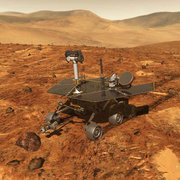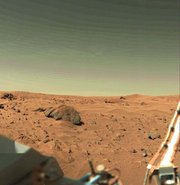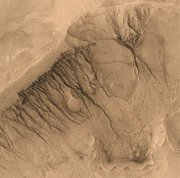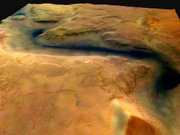Exploration of Mars
|
|
The exploration of Mars has been an important part of the space exploration missions of the Soviet Union (later Russia), the United States, Europe, and Japan. Dozens of unmanned spacecraft, including orbiters, landers, and rovers, have been launched toward Mars since the 1960s. These missions were aimed at gathering data and answering questions about the red planet and its past that may yield further insight into Earth's past, present, and future.
The exploration of Mars has come at a considerable financial cost with roughly two-thirds of all spacecraft destined for Mars failing before completing or even beginning their missions. Part of this high failure rate can be ascribed to the large number of things that can go wrong, but enough have either failed or lost communications for no apparent reason that some researchers half-jokingly speak of an Earth-Mars "Bermuda Triangle" or of a Great Galactic Ghoul which subsists on a diet of Mars probes.
| Contents |
Questions to explore
Mars has long been the subject of human fascination. Early telescopic observations revealed color changes on the surface which were originally attributed to seasonal vegetation and linear features which were ascribed to intelligent design. These early and erroneous interpretations led to wide public interest in Mars. Other telescopic observations found Mars' two tiny moons, dry channels and depressions,Polar ice caps, Olympus Mons, the solar system's tallest mountain, and Valles Marineris, the solar system's largest canyon system. These discoveries have only piqued further interest in the study and exploration of the red planet. Mars is a rocky planet, like Earth, that formed around the same time, yet it is only between one-quarter and one-third the surface area and its surface is cold and desert-like. Among the questions asked by scientists are the following:
- How does the composition of Mars differ from the Earth's and how have the two planets evolved differently?
- How does the composition and state of the interior of Mars differ from the Earth's?
- Is Mars still geologically active?
- What natural resources are available at the surface for future human use?
- Was there an early dense atmosphere on Mars?
- Did Mars once have oceans?
- What changes in climate has Mars experienced over its geologic history and what caused those changes?
- How stable is the climate of Mars today?
- Did chemical evolution take place on Mars, leading to the formation of prebiotic organic molecules?
- Did chemical evolution lead to the formation of replicating molecules, i.e. life?
- If life once arose, is it to be found anywhere on Mars today?
Launch windows
In order to understand the history of the robotic exploration of Mars it is important to note that launch windows occur at intervals of 2.135 years, i.e. 780 days (the planet's synodic period). Launch windows were / will be in:
- Nov/Dec 1996
- December 1998-January 1999
- April 2001
- June-July 2003
- August 2005
- October 2007
- December 2009
Early flyby probes and orbiters
Early Soviet missions
The Soviet space program launched two flyby probes towards Mars in October 1960, dubbed Mars 1960A and Mars 1960B, but both failed to reach Earth orbit. In 1962, three more Soviet probes failed -- two remaining in Earth orbit (Mars 1962A and Mars 1962B) and one losing communication with Earth en route to Mars (Mars 1). In 1964, the Soviet Zond 2 was another failed attempt to reach Mars.
Mariner program
Mars_(Mariner_4).jpg
In 1964, NASA's Jet Propulsion Laboratory made two attempts at reaching Mars. Mariner 3 and Mariner 4 were identical spacecraft designed to carry out the first flybys of Mars. Mariner 3 was launched on November 5, 1964, but the shroud encasing the spacecraft atop its rocket failed to open properly, and it failed to reach Mars. Three weeks later, on November 28, 1964, Mariner 4 was launched successfully on an eight-month voyage to the red planet.
Mariner 4 flew past Mars on July 14, 1965, providing the first close-up photographs of another planet. The pictures, gradually played back to Earth from a small tape recorder on the probe, showed lunar-type impact craters. Some of them seemed touched with frost in the chill of a Martian evening.
NASA continued the Mariner program with another pair of Mars flyby probes at the next launch window. These probes reached the planet in 1969. See Mariner 6 and 7 for details. During the following launch window the Mariner program again suffered the loss of one of a pair of probes. Mariner 9 successfully entered orbit about Mars, after the launch time failure of its sister ship, Mariner 8. When Mariner 9 reached Mars, it and two Soviet orbiters (Mars 2 and Mars 3, see Mars probe program below) found that a planet-wide dust storm was in progress. The mission controllers used the time spent waiting for the storm to clear to have the probe rendezvous with, and photograph, Phobos. When the storm cleared sufficiently for Mars' surface to be photographed by Mariner 9, the pictures returned represented a substantial advance over previous missions. These pictures were the first to offer evidence that liquid water might at one time have flowed on the planetary surface.
Landers and later missions
Mars probe program
In 1971, shortly after Cosmos 419 failed to launch, the Soviet Union successfully sent Mars 2 and Mars 3, nearly a decade after the launch of Mars 1, all part of the Mars probe program. The Mars 2 and 3 probes each carried a lander, both arriving on Mars in 1971. The Mars 2 lander entered Mars' atmosphere at too steep an angle, causing it to crash, and the Mars 3 lander functioned for only 20 seconds after landing. They were the first human artifacts to touch down on Mars.
In 1973, the Soviet Union sent four more probes to Mars: the Mars 4 and Mars 5 orbiters and the Mars 6 and Mars 7 flyby/lander combinations. Of the four, only Mars 5 succeeded; it transmitted 60 images before suffering a transmitter failure. Mars 6's lander transmitted data during descent but failed on impact. Mars 4 and 7 both missed the planet.
Viking program
In 1976 the two Viking probes entered orbit about Mars and each released a lander module that made a successful soft landing on the planet's surface. The two missions returned the first color pictures and extensive scientific information. Measured temperatures at the landing sites ranged from 150 to 250 K, with a variation over a given day of 35 to 50 K. Seasonal dust storms, pressure changes, and movement of atmospheric gases between the polar caps were observed. A biology experiment produced possible evidence of life, but it was not corroborated by other on-board experiments. Most scientists believe there is not current life on Mars.
While searching for a suitable landing spot for Viking 2's lander, the Viking 1 orbiter photographed the landform that constitutes the so-called "Face on Mars" on July 25, 1976.
The Viking program was a descendant of the cancelled Voyager program, whose name was later reused for a pair of outer solar system probes.
Phobos program
The Soviet Union went to Mars again in 1988 with the Phobos 1 and 2 probes to study the planet and its moons Phobos and Deimos. Phobos 1 lost contact on the way to Mars and Phobos 2 failed just before it was set to release two landers on Phobos' surface.
Mars Global Surveyor
After the 1992 failure of NASA's Mars Observer orbiter, NASA retooled and launched Mars Global Surveyor. This mission was the first successful one to the red planet in two decades when it launched November 7, 1996, and entered orbit on September 12, 1997. After a year and a half trimming its orbit from a looping ellipse to a circular track around the planet, the spacecraft began its primary mapping mission in March 1999. It has observed the planet from a low-altitude, nearly polar orbit over the course of one complete Martian year, the equivalent of nearly two Earth years. Mars Global Surveyor completed its primary mission on January 31, 2001, and is now in an extended mission phase.
The mission has studied the entire Martian surface, atmosphere, and interior, and has returned more data about the red planet than all other Mars missions combined. These valuable data are archived at http://pds-geosciences.wustl.edu/missions/mgs/index.html
Among key scientific findings so far, Global Surveyor has taken pictures of gullies and debris flow features that suggest there may be current sources of liquid water, similar to an aquifer, at or near the surface of the planet. Similar channels on Earth are formed by flowing water, but on Mars the temperature is normally too cold and the atmosphere too thin to sustain liquid water. Nevertheless, many scientists hypothesize that liquid groundwater can sometimes surface on Mars, erode gullies and channels, and pool at the bottom before freezing and evaporating.
Magnetometer readings show that the planet's magnetic field is not globally generated in the planet's core, but is localized in particular areas of the crust. New temperature data and closeup images of the Martian moon Phobos show its surface is composed of powdery material at least 1 metre (3 feet) thick, caused by millions of years of meteoroid impacts. Data from the spacecraft's laser altimeter have given scientists their first 3-D views of Mars' north polar ice cap.
Mars Pathfinder
The Mars Pathfinder spacecraft, launched one month after Global Surveyor, landed on July 4, 1997. Its landing site was an ancient flood plain in Mars' northern hemisphere called Ares Vallis, which is among the rockiest parts of Mars. It carried a tiny remote-controlled rover called Sojourner, which traveled a few meters around the landing site, exploring the conditions and sampling rocks around it. Newspapers around the world carried images of the lander dispatching the rover to explore the surface of Mars in a way never done before at any extra-terrestrial location.
Until the final data transmission on September 27, 1997, Mars Pathfinder returned 16,500 images from the lander and 550 images from the rover, as well as more than 15 chemical analyses of rocks and soil and extensive data on winds and other weather factors. Findings from the investigations carried out by scientific instruments on both the lander and the rover suggest that Mars was at one time in its past warm and wet, with water existing in its liquid state and a thicker atmosphere. The mission website was the most heavily-trafficked up to that time.
Spate of failures
Following the success of Global Surveyor and Pathfinder, another spate of failures occurred in 1998 and 1999, with the Japanese Nozomi orbiter and NASA's Mars Climate Orbiter, Mars Polar Lander, and Deep Space 2 penetrators all suffering various fatal errors. Mars Climate Orbiter is infamous for project engineers mixing up the usage of imperial units with metric units, causing the orbiter to burn up while entering Mars' atmosphere.
Mars Odyssey
In 2001 the run of bad luck ended when NASA's Mars Odyssey orbiter arrived. Its mission is to use spectrometers and imagers to hunt for evidence of past or present water and volcanic activity on Mars. In 2002, it was announced that the probe's gamma ray spectrometer and neutron spectrometer had detected large amounts of hydrogen, indicating that there are vast deposits of water ice in the upper three meters of Mars' soil within 60° latitude of the south pole.
Mars Express
On June 2, 2003, the European Space Agency's Mars Express set off from Baikonur Cosmodrome to Mars. The Mars Express craft consists of the Mars Express Orbiter and the lander Beagle 2. Although the landing probe was not designed to move, it carried a digging device and possibly the smallest mass spectrometer, as well as a range of other devices, on a robotic 'arm' in order to accurately analyse soil beneath the dusty surface.
The orbiter entered Mars orbit on December 25, 2003, and Beagle 2 entered Mars' atmosphere the same day. However, attempts to contact the lander failed. Communications attempts continued throughout January, but Beagle 2 was declared lost in mid-February, and a joint inquiry was launched by the UK and ESA. Nevertheless, Mars Express Orbiter confirmed the presence of water ice and carbon dioxide ice at the planet's south pole. NASA had previously confirmed their presence at the north pole of Mars.
Mars Exploration Rovers
Shortly after the launch of Mars Express, NASA sent a pair of twin rovers toward the planet as part of the Mars Exploration Rover Mission. On June 10, 2003, NASA's MER-A (Spirit) Mars Exploration Rover was launched. It successfully landed in Gusev Crater (believed once to have been a crater lake) on January 3, 2004. It examined rock and soil for evidence of the area's history of water. On July 7, 2003, a second rover, MER-B (Opportunity) was launched. It landed on January 24, 2004 in Meridiani Planum (where there are large deposits of hematite, indicating the presence of past water) to carry out similar geological work.
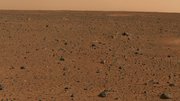
Despite technical difficulties with the rovers (believed to have been caused by corrupted flash memory) delaying exploration for several days, both rovers eventually began exploring their landing sites. The rover Opportunity landed in a particularly interesting spot, a crater with bedrock outcroppings. In fast succession mission team members announced on March 2 that data returned from the rover showed that these rocks were once "drenched in water", and on March 23 that it was concluded that they were laid down under-water in a salty sea. This represented the first strong direct evidence for liquid water being on Mars at some time in the past.
As of January 28, 2005, both rovers are still healthy and discovering new things, including Heat Shield Rock, the first meteorite to be discovered on another planet.
Manned missions
Many people, from Wernher von Braun on, have long advocated a manned mission to Mars as the next logical step for a manned space program after lunar exploration. Aside from the prestige such a mission would bring, advocates argue that humans would be easily able to outperform robotic explorers, justifying the expenses.
Because of the distance between Mars and Earth, the mission would be much more risky and more expensive than past manned flights to the Moon. Supplies and fuel would have to be prepared for a 2-3 year round trip and the spacecraft would have to be designed with at least partial shielding from intense solar radiation. A proposal called Mars Direct, forcefully advocated by Robert Zubrin of the Mars Society, is believed by many to be the most practical and affordable plan for a manned Mars mission.
United States President George W. Bush announced a broad initiative of manned space exploration on January 14, 2004, known as the Vision for Space Exploration. It includes a manned return to the moon by 2015 at the earliest, and suggests that manned missions to Mars may become a possibility at some point in the future. The European Space Agency has the long-term vision of sending a human mission to Mars by 2030, the Aurora Programme.
In the even longer term (centuries hence), some scientists believe Mars to be a good candidate for terraforming and human colonization, though other prominent skeptics (such as Robert L. Park) dispute the practicality of both. Many scientists have argued that if life is found on Mars, all human activities on the planet should be carried out with the goal of preservation in mind. Others argue that the presence of life on Mars would imply that life is prevalent throughout the universe; decreasing the relative importance of Martian microbes.
Paul Davies, professor at the Australian Centre for Astrobiology, believes that a one-way mission to Mars will greatly reduce the cost and technical difficulties of manned exploration.
Timeline of Mars exploration
Dates listed are spacecraft launch dates.
1960s
- Marsnik 1 (Mars 1960A) - 10 October 1960 - Attempted Mars Flyby (Launch Failure)
- Marsnik 2 (Mars 1960B) - 14 October 1960 - Attempted Mars Flyby (Launch Failure)
- Sputnik 22 (Mars 1962A)- 24 October 1962 - Attempted Mars Flyby
- Mars 1 - 1 November 1962 - Mars Flyby (Contact Lost)
- Sputnik 24 (Mars 1962B) - 4 November 1962 - Attempted Mars Flyby
- Mariner 3 - 5 November 1964 - Attempted Mars Flyby
- Mariner 4 - 28 November 1964 - Mars Flyby
- Zond 2 - 30 November 1964 - Mars Flyby (Contact Lost)
- Zond 3 - 18 July 1965 - Lunar Flyby, Mars Test Vehicle
- Mariner 6 - 25 February 1969 - Mars Flyby
- Mariner 7 - 27 March 1969 - Mars Flyby
- Mars 1969A - 27 March 1969 - Attempted Mars Orbiter (Launch Failure)
- Mars 1969B - 2 April 1969 - Attempted Mars Orbiter (Launch Failure)
1970s
- Mariner 8 - 8 May 1971 - Attempted Mars Flyby (Launch Failure)
- Cosmos 419 - 10 May 1971 - Attempted Mars Orbiter/Lander
- Mars 2 - 19 May 1971 - Mars Orbiter/ Attempted Lander
- Mars 3 - 28 May 1971 - Mars Orbiter/ Lander (Contact lost shortly after landing)
- Mariner 9 - 30 May 1971 - Mars Orbiter
- Mars 4 - 21 July 1973 - Mars Flyby (Attempted Mars Orbiter)
- Mars 5 - 25 July 1973 - Mars Orbiter
- Mars 6 - 5 August 1973 - Mars Lander (Contact Lost)
- Mars 7 - 9 August 1973 - Mars Flyby (Attempted Mars Lander)
- Viking program
1980s
- Phobos program
- Phobos 1 - 7 July 1988 - Attempted Mars Orbiter/Attempted Phobos Landers
- Phobos 2 - 12 July 1988 - Mars Orbiter/Attempted Phobos Landers
1990s
- Mars Observer - 25 September 1992 - Attempted Mars Orbiter
- Mars Global Surveyor - 7 November 1996 - Mars Orbiter
- Mars 96 - 16 November 1996 - Attempted Mars Orbiter/Attempted Landers
- Mars Pathfinder - 4 December 1996 - Mars Lander and Rover. Success
- Nozomi (Planet-B) - 3 July 1998 - Attempted Mars Orbiter
- Mars Surveyor 1998 - Attempted Mars Orbiter and Lander
- Mars Climate Orbiter - 11 December 1998 - Attempted Mars Orbiter
- Mars Polar Lander - 3 January 1999 - Attempted Mars Lander
- Deep Space 2 (DS2) - 3 January 1999 - Attempted Mars Penetrators
2000s
- Mars Surveyor 2001
- Mars Surveyor 2001 Lander - Cancelled
- Mars Odyssey - 7 April 2001 - Mars Orbiter
- Mars Express - 2 June 2003 - Mars Orbiter and Attempted Lander
- Mars Express Orbiter
- Beagle 2 - Attempted Lander
- Mars Exploration Rovers (MER)
- MER-A Spirit - 10 June 2003 - Mars Rover
- MER-B Opportunity - 7 July 2003 - Mars Rover
- Rosetta - 2 March 2004 - Mission to a comet, Mars Flyby in 2007
Scheduled/Planned
- Mars Reconnaissance Orbiter - 10 August 2005 - Mars Orbiter
- Phoenix - August 2007 - Small Mars Scout Lander
- NetLander - 2009 - Mars Netlanders (Cancelled)
- Phobos-Grunt - October 2009 - Mars Orbiter and Phobos Sample Return
- Mars Telecommunications Orbiter - November 2009 - Mars Orbiter for telecommunications
- Mars Science Laboratory - 2009 or 2011 - Rover
- ExoMars - 2011 - Rover (ESA)
- Mars 2011 - 2011 - Scout Mission
- Mars Sample Return Mission (http://mars.jpl.nasa.gov/missions/future/futureMissions.html) - not until 2013 - Planned mission by ESA and NASA as part of the Aurora Programme
See also
External link
- exploreMarsnow (http://www.exploremarsnow.org/) Interactive Mars base simulation. Winner of 2003 Webby Award for Science.
- Next on Mars (http://www.spacedaily.com/news/mars-future-05f.html) (Bruce Moomaw, Space Daily, March 9, 2005): An extensive overview of NASA's Mars exploration planses:Exploración de Marte
fr:Exploration de la plančte Mars nl:Ruimtevluchten naar Mars pl:Badania Marsa

